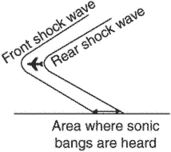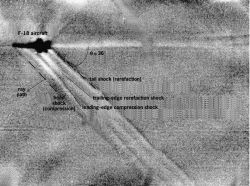sonic boom
Sonic boom
An audible sound wave generated by an object that moves faster than the speed of sound (supersonic object). The sonic boom forms because the air is pushed away faster than the air molecules can move. The displaced air becomes highly compressed and creates a very strong sound wave, referred to as a compressional head shock or bow shock. At the back of the supersonic object the air has to fill the void left as the object moves forward; in this case, the gas becomes rarefied and a rarefractional tail shock develops. These shock waves are the main components of a sonic boom, and they are generated the entire time that an object flies faster than the speed of sound, not just when it breaks the sonic barrier. See Shock wave
Sonic booms may be natural or generated by human activity. A natural sonic boom is thunder, created when lightning ionizes air, which expands supersonically. Meteors can create sonic booms if they enter the atmosphere at supersonic speeds. Human sources of sonic booms include aircraft, rockets, the space shuttle during reentry, and bullets.
Sonic booms are commonly associated with supersonic aircraft. The shock waves associated with sonic booms propagate away from the aircraft in a unique fashion. These waves form a cone, called the Mach cone, that is dragged behind the aircraft. The illustration shows the outline of the Mach cone generated by an F-18 fighter aircraft flying at Mach 1.4. The schlieren photographic technique was used to display the sonic boom, which is normally invisible. The half-angle of the cone is determined solely by the Mach number of the aircraft, Θ = arctan (1/M), 36° for M = 1.4. The shock waves travel along rays that are perpendicular to the Mach cone (see illustration). As the Mach number increases, Θ becomes smaller and the sound travels almost directly downward. See Mach number, Schlieren photography
The typical peak pressure amplitude (or overpressure) of a sonic boom on the ground is about 50–100 pascals. A sonic boom with 50 Pa (1 lbf/ft2 or 0.007 psi) overpressure will produce no damage to buildings. Booms in the range of 75–100 Pa are considered disturbing by some people. Occasionally there is minor damage to buildings from sonic booms in the range of 100–250 Pa; however, buildings in good condition will be undamaged by overpressures up to 550 Pa. Very low flying aircraft (30 m or 100 ft) can produce sonic booms of 1000–7000 Pa. These pressures are still about five times less than that needed to injure the human ear, but can lead to damage to buildings, such as the breaking of glass windows and the cracking of plaster. Although sonic booms are not dangerous, they can evoke a strong startle response in people and animals.
sonic boom
[′sän·ik ′büm]sonic boom

